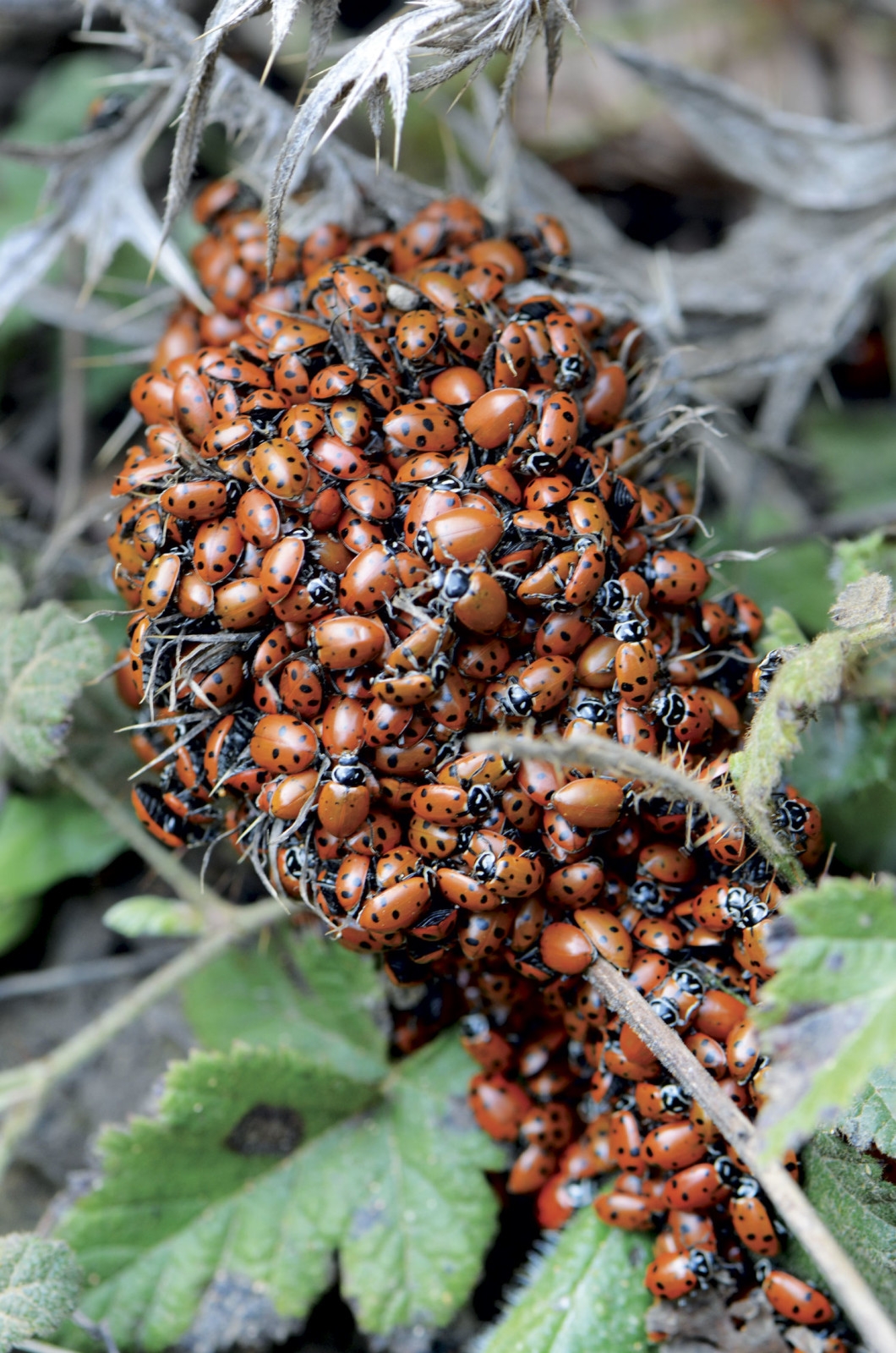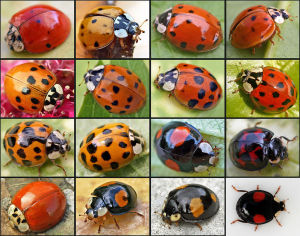When I arrive at the narrow stacks of the UC Berkeley’s Essig Museum of Entomology, senior museum scientist Peter Oboyski has laid out a ladybug specialist’s treasure trove for us to examine: Hundreds of ladybug specimens, representing species from both hemispheres, are pinned in crowded rows to their boxes. It’s hard to believe these creatures are all “ladybugs”—members of the nearly 6,000-species ladybird beetle family Coccinellidae. A bulky, tank-like specimen from Mexico is spotless while an elongated black one from Cusco, Peru, has yellow spots and resembles a glamorized tick. But most of the specimens are from California, and to the left of the tank insect I notice a row of more familiar ladybugs from nearby Strawberry Creek. Red with thirteen spots, these represent the convergent ladybug (Hippodamia convergens), one of the Bay Area’s most conspicuous wintertime species. I’m here to learn its story.
Convergent ladybugs—among the most common of California’s 175 native ladybug species—have overwintered in groups of as many as hundreds of thousands in the Bay Area hills, clustering together on vegetation or rocks. Born in spring as long alligator-shaped larvae in lowland habitats—most likely along the coast or the Central Valley— adults migrate to the hills in late summer or early fall, following wind currents, prominent features in the landscape, and messaging chemicals called pheromones to overwintering sites. Groups often form in the same general site for generations, swamping logs, trees, rocks, and fallen leaves in waves of stirring red and black bodies. The insects spend the winter in mild hibernation, moving slowly and rarely eating as they wait for temperatures to warm again in late winter or early spring. Then, many individuals mate (others will have mated before leaving their spring habitat, but delayed reproduction until after hibernation) before dispersing to the lowlands to give birth, die, and so restart the ladybug’s annual life cycle.

Convergent ladybugs haven’t always migrated at these times, though, Oboyski tells me when we sit down. Most individuals once left their spring habitats in early summer, when plants dried and aphids, their primary food source, declined. But the spread of irrigated landscapes like farms, parks, and gardens has allowed more aphids, and so ladybugs, to persist in low areas through the summer. For instance, many Central Valley ladybugs migrate to the Sierra Nevada, where they eat pollen and nectar to store fat at higher elevations before gathering in the lower foothills to overwinter. Individuals now tend to migrate later in the season to both Sierra Nevada and Bay Area hills.
A popular and now feted Bay Area location for ladybug sightseeing is along the Stream Trail in Redwood Regional Park, where local resident Jeremy Brautman maintains an elaborate “Ladybug Hotel” for the seasonal spotted wayfarers. Built from an old cedar and redwood birdhouse with moss and reeds added on site, the structure includes a bamboo “suite,” a lichen-covered “penthouse,” and an oak-leaf “clam shell,” along with amenities such as “fern leaf yoga” and “organic bedding.” (However, park staff strongly discourage residents from leaving such installations in parks.) Less lavishly accommodated travelers’ groups can be found throughout the Bay Area, including at Muir Woods National Monument, Mount Diablo, Pinnacles National Park, and Strawberry Canyon.
While the convergent ladybug is one of the most noticeable wintertime species, the Bay Area is home to at least a dozen ladybug species throughout the year. Native two-spotted, five-spotted, three-banded, and sinuate ladybugs can all be found here, along with the (usually spotless) polished, California, and Western blood-red ladybugs. The nonnative seven-spotted ladybug is also a familiar resident. While many species’ common names refer to wing markings, this trait can vary among individuals of the same species, so the best identifying feature is a distinct pattern on the smaller neck-like area called a pronotum. The abundant nonnative multicolored Asian ladybug, for instance, can have between zero and more than 16 spots, but its yellow pronotum frequently displays a distinct black “M.” Like the convergent ladybug, this species gathers in large groups to overwinter, though it can be a pest for people when it congregates indoors.
As regular and noticeable as these massive aggregations are, scientists are still uncertain about their purpose, Oboyski says. Most ladybug species overwinter, but many do so alone or in small groups. Some scientists believe certain species gather in larger numbers simply to stay warm; others hypothesize it is for predator protection, to find mates more easily before dispersing, or some combination of the three. In general, a surprising amount is still unknown about the seemingly familiar ladybug, particularly its overwintering behavior. As the authors of the 2012 Ecology and Behaviour of the Ladybird Beetles—a book one ladybug researcher called the “ladybug Bible”—write, “Although usually a very long phase of the life cycle, diapause/dormancy [i.e. overwintering], has lately attracted much less research activity than other topics. This is unfortunate….
Of course, humans have watched and been intrigued by ladybugs for centuries. The ladybug’s bright red and black coloring serves to warn predators of its toxic blood, which it excretes through its joints when threatened in a process called “reflex bleeding.” But its pleasing design has also made the ladybug one of a small number of insects with almost universally positive connotations. Many cultures attach good-luck myths to the ladybug, an attitude often reflected in its common names, many of which evoke beneficent religious figures: For instance, the British “lady beetle,” German Marienkäfer (“Mary’s beetle”), Norwegian marihøne (“Mary’s hen”), and American “ladybug” are all thought to refer to “Our Lady” the Virgin Mary, while the Irish bóín dé (“God’s little cow”) and Hebrew parat Moshe Rabbeinu (“Moses’ cow”) have other divine connotations. (Because the ladybug is taxonomically a beetle, many American entomologists prefer the more accurate British name.) In Turkey, meanwhile, the insect is known simply as ugur böcegi, or “good luck bug.”
Associations aside, the ladybug is a remarkably beneficial insect for humans. Most ladybug species are important predators of aphids and other agricultural pests, with some species able to consume hundreds of aphids each day. In the late 1800s, an Australian ladybug introduced to Southern California citrus groves served as an early biological control agent, and this potential for natural pest control remains a popular area of ladybug research.
Unfortunately, other introduced species—particularly the seven-spotted and multicolored Asian ladybugs—have begun to displace native ladybugs in California and throughout the United States, likely by consuming more prey and reproducing in greater numbers. Both nonnative species are now frequently found in the Bay Area. The Cornell-based Lost Ladybug Project is researching this shift by encouraging citizens across the country to send pictures of observed ladybugs to the project site (lostladybug.org), where the species are verified and their locations marked on a publicly available map.
The Bay Area currently hosts one of the highest concentrations of observations for the rare native two-spotted ladybug, another focus of the project. We can also help native ladybugs by encouraging them to visit our gardens, but buying a box of ladybugs from the local garden supply store likely won’t do the job, Oboyski tells me. These are usually convergent ladybugs harvested during hibernation, and the insects will disperse on waking. Instead, you’re better off growing plant varieties that will attract native ladybugs, he says.
Before I leave the Museum of Entomology, Oboyski pulls out one more ladybug case to show me. Inside, hundreds of convergent ladybugs from the Western United States are packed tightly together. The collection is impressive, but I know it equals only a fraction of a single aggregation that forms every winter in the hills above us. Staring at these still specimens, I try to imagine the spectacle: hundreds of thousands of red and black splotches massing across the forest floor, blanketing logs, rocks, leaves, and everything else around them. Luckily, we can see it for ourselves every year.




-300x196.jpg)